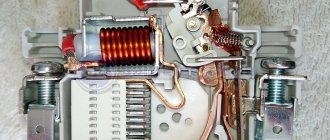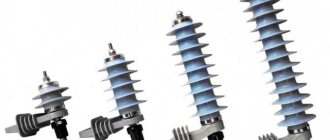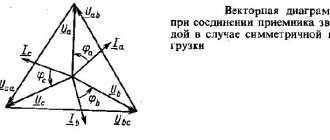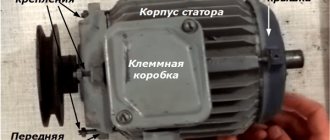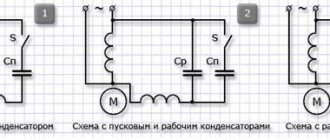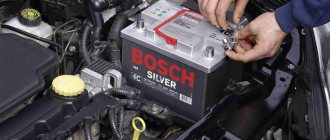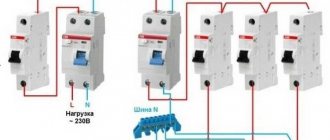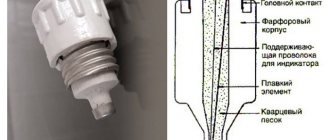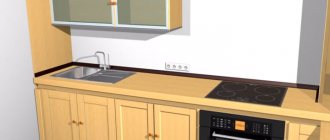One of the main tasks of the indoor electrical network is to ensure the safety of people and the safety of electrical appliances. The presence of residual current devices (RCDs) in the network does not guarantee complete safety; they only protect against voltage surges and short circuits.
But if you choose the right protective devices and think through the circuit diagram for connecting the RCD, then the level of protection will be maximum. In this article you will learn how to correctly connect an RCD to an existing power supply circuit.
Purpose and operating principle of RCD
The operation of the residual current device is based on a constant comparison of the current values that flow through the phase and neutral conductors. If you touch a live wire, some of the current will pass through the human body. Almost instantly (0.2-0.4 seconds) the RCD trips and cuts off the current, because the values of the phase and zero currents are unequal.
Installation of heated electric floors: types, power calculations, pitch
An RCD will not only save you from electric shock, but also prevent fires. If the insulation is damaged, current leakage begins. At the point of current leakage, heating occurs and the wiring may catch fire. If there is a shutdown protection device in the circuit, this situation is impossible.
If your apartment currently does not have a security device, we recommend purchasing one. How to connect an RCD before or after the machine, what other types of protective devices exist, we will consider further.
Briefly about the main thing
For most ordinary people, it is a mystery what an RCD is in electrical engineering and how to connect it correctly. But the safety of their home and everyone living in it actually depends on this device. It protects against possible current leakage in the network, and its use is especially important in rooms where there is no grounding.
There are quite a few types of RCDs, because... they are available for circuits with alternating or direct current, for single-phase or three-phase networks. In addition, they all differ in operating current parameters, of which there are quite a few. And you should not confuse an RCD with an automatic shutdown device; they have different tasks.
Professionals recommend installing, in addition to the general protection device, a separate device for each operating circuit.
RCD selection
So what should you choose? Installation of RCD + automatic or difavtomatic? The first option is cheaper, and the second takes up less space in the electrical room. There is one more advantage in favor of the first option. If one of the devices fails, replacement will be cheaper. To properly protect your electrical network, you need to select the correct parameters of protective devices. Let's take a look at how they differ and what is right for you.
You may be interested in the article “Soldering polypropylene pipes: temperature table, installation instructions + top best pp systems” Go>>
Selection by parameters
Based on sensitivity, RCDs are divided into two types:
- protect against electric shock;
- fire protection
For the first type, the current value is set, taking into account that a current of 50 mA is dangerous for humans.
The choice also depends on the room in which the protection device is used.
Choose from two types:
- At 10 mA, if the room has high humidity (bathtub, kitchen, swimming pool, bathroom), for connecting washing machines and boilers.
- At 30 mA, if the room conditions are normal.
It is not recommended to install an RCD with a sensitivity of less than 10 mA; there is a high probability of false shutdown.
The fire-fighting type of RCD according to the current value is divided into:
- 100 mA;
- 200 mA;
- 300 mA.
Selection by type
Let's decide on the second parameter. According to the type of current leakage, they are divided into the following classes:
- AC - alternating current. Suitable for apartments, they can be connected to: warm electric floors, refrigerators and freezers, boilers, electric heating devices.
- A - for alternating and rectified (pulsating) current. Suitable for devices with switching power supplies or rectifiers. These are televisions, computers, microwaves, dishwashers and washing machines.
- B - suitable for any current, but are not used in the house.
We also pay attention to the delay time before shutdown. Suitable for home and apartment without delay. Response time from 2 ms to 3 ms.
If you have decided on the choice of protective devices, then move on to connecting them to the network.
Selecting a device taking into account design parameters
The process of designing electrical installations by specialized design organizations should include the rather complex task of selecting suitable RCDs from the assortment of the electrical equipment market.
The variety of RCD devices on the commercial market forces the future user to carefully approach the process of selecting a device. The wide range available provides a varied choice, but does not guarantee quality and compliance with parameters
This task is really difficult. The modern market of electrical appliances, including RCDs, is distinguished by a unique assortment. This is the result of the lack of strict quality control on the part of government agencies.
There are a lot of different devices on the market, manufactured by a large number of manufacturers, many of which do not always adhere to current regulations.
The potential owner of the RCD has no choice but to accept the information provided by the device manufacturer. The guarantee is supplemented by a certificate of conformity and fire safety.
The absence of such documents for the product being sold is a direct ban on installation and operation, in accordance with the requirements of current standards.
One such document, a certificate of conformity, must be supplied with any device that is put on sale. If the RCD device does not have a certificate of conformity, this is already a clear reason for refusing to purchase (+)
The choice of an RCD is always accompanied by taking into account the operating operational parameters and characteristics, which largely determine the quality and reliability of the device.
It is necessary to take into account the nominal indicators:
- tension;
- current;
- differential cut-off current.
These main characteristics must correspond to the technical parameters of the electrical installation being designed or the electrical circuit being operated.
The quality and reliability of an RCD is determined by certain indicators, the general physical meaning of which is often poorly understood.
These parameters are, first of all, the rated conditional short-circuit current and the rated making/breaking capacity current.
The main operating parameters of devices such as RCDs are traditionally displayed directly on the panel of the device itself. However, along with the main parameters, there are also a number of somewhat secondary ones, which also have a significant impact on the operation of the devices (+)
It is very rare that RCD manufacturers note all the noted characteristics in the documents for the devices. Therefore, it is necessary to correctly evaluate all the existing advantages and disadvantages of the selected devices.
From a technical design point of view, an RCD is traditionally characterized as a switching device whose operation is determined by the standby mode. The device does not have any features that help visually determine the quality of work.
But there is a single principle on the basis of which such devices function in the same way. The device is connected to the operating current circuit and if a leakage current appears with a certain value exceeding the set value, the RCD simply opens the power circuit.
Despite the variety of designs of RCDs, in fact the principle of operation of these devices remains monotonous. The main operating principle of the device is to de-energize the electrical circuit in case of violation of the set current leakage parameter (+)
How correctly is the opening performed? It is possible to evaluate the performance of the device circuit, switching capacity, service life and other significant parameters only by specialized tests.
RCD diagram in a single-phase voltage network
Today, many manufacturers of household appliances recommend using protective devices when installing electrical wiring. It is advisable to additionally secure such household appliances as: washing machine, boiler, dishwasher. If we take into account that a modern electrical network in an apartment consists of several circuits designed for different loads, then there will also be several options for placing an RCD in the circuit.
Installation of electrical wiring in a wooden house
For apartments and private houses, a single-phase network is most often used. There are two possible wire options:
- With two wires. One wire is phase, the other is neutral. Which wire is which can be determined using a simple tester in the form of a screwdriver. The light on the phase wire will light up. This is an old Soviet design.
- Three wires: phase, neutral and ground. This is a modern design that came to us from abroad.
Let's consider popular circuits for connecting RCDs in a single-phase network.
Scheme without grounding
In the case when the house has single-phase electrical wiring without grounding and a simple connection diagram for all devices, i.e. there are no separate circuits for lighting, sockets, and household appliances. Then, for protection, one common RCD is used for all devices.
Connecting an RCD to an electrical circuit is not difficult. It is necessary to connect the protection device to the wires that enter the apartment or house. When connecting, observe polarity.
The phase wire is to terminal L, and the neutral wire is to terminal N. In this case, it is recommended to use an RCD with a sensitivity of 30 mA and a load of 25 A.
The disadvantage of this scheme is the difficulty of determining a leak in the network when an RCD is triggered. But this is a very simple and inexpensive way to protect electrical appliances.
Circuit with ground wire
If the apartment or house uses single-phase electrical wiring with grounding, then connecting the RCD to the network is similar to the previous option. The same type of RCD is used and the connection is made in the same way. The phase wire is to terminal L, and the neutral wire is to terminal N. The ground wire (yellow-green) is not used.
The diagram shows the connection of an RCD in a single-phase network with grounding.
Connecting an RCD with grounding
In modern apartments and private houses, specialists today use electrical wiring with grounding. Together with RCDs, other protection devices are used: circuit breakers, voltage relays.
Depending on the number of household appliances, lighting fixtures, the presence of a swimming pool, saunas, the electrical network circuit has many circuits. Therefore, the installation of an RCD and its position in the circuit depends on many factors.
Let's consider several options for such connections.
General RCD at input
If the house or apartment is small and the wiring is in good condition, then you can use the simplest RCD connection diagram. Installation of the RCD in the circuit is mounted at the input.
Connecting an RCD at the input
This connection has a number of advantages:
- not expensive;
- easy to install;
- does not require changes in the electrical network;
- takes up little space.
You may be interested in the article “How to connect a washing machine yourself: step-by-step installation instructions” Go>>
But there are also disadvantages:
- if a leak occurs, the entire house will lose power;
- it is not possible to separate electrical appliances by leakage current;
- false shutdowns may occur;
- Finding the problem area becomes difficult.
General input RCD and single-phase meter
Connection diagram for RCD with single-phase meter:
Connecting an RCD after the meter
The following connection diagram is more often found in a private home. If everything is done correctly, then there is a common machine in front of the electricity meter.
In this case, the RCD is connected after the meter. If the meter is in a special sealed box, then we connect the RCD to the wires that come out of it. The phase wire is to terminal L, and the neutral wire is to terminal N.
When you connect directly to the terminals of the electric meter, be careful. You may be fined for incorrect connection.
Connection to the meter:
- connect the second terminal to terminal L;
- the fourth with terminal N.
Introductory and group RCD with electric meter
Connecting protection at the input and for each group
This connection is the safest and most practical. During major renovations or construction, such a scheme is often used today. Let's consider how to connect the RCD in this case.
The entire electrical network of the house is divided into separate circuits. Each of these circuits is controlled by a separate protection group - RCD + AB. A common RCD is also connected to the circuit. We get double protection against current leakage.
Another advantage of this connection scheme is that it is much easier to determine the current leakage when the protection is triggered. The search is narrowed down to devices in the same circuit.
To prevent simultaneous shutdown of the general RCD and in the circuit, it is necessary to correctly select the shutdown time and current values.
If a shutdown still occurs, it means that there are problems with the RCD in one of the circuits:
- out of order;
- with marriage;
- the load is not selected correctly.
The disadvantages of this scheme are the large workload of the electrical panel and its high cost.
Only group RCD networks
This connection option is also found. The only difference from the previous scheme is the absence of a common RCD. This scheme is also quite reliable.
Of course, in such a connection we rely on the reliable operation of one device. Therefore, you should not skimp on protection devices and purchase them from reliable manufacturers.
RCD Installation Guide
Before you correctly connect the RCD according to the recommendations outlined, you should decide on its location. The choice consists of two options - to mount it in a panel or in a cabinet.
The first one looks like a metal box without a lid, mounted on the wall so that it is convenient to use.
The cabinets are equipped with doors that can be closed with a lock. There are types of cabinets that have windows for convenient reading of the meter without opening the doors.
According to generally accepted rules, the neutral wire is connected to the terminals, which are located on the left, and the phase wire - on the right. This applies to both entering and exiting the device. Those. in a three-phase network, the left incoming and outgoing (upper and lower) terminals on the RCD will be in contact with the “zero”, and the remaining 3 incoming and 3 outgoing connectors, located to the right, are intended for contact with the “phases”.
An example of the simplest installation option, not done professionally Source simpalsmedia.com
Attention! There are protective devices in which the placement of neutral and phase terminals does not meet the standards. In such cases, manufacturers, as a rule, mark the neutral connector with the letter “N”, and the phase connector with “L” (or only one of the terminals with one symbol).
In a single-phase network, the device terminals are distributed as follows:
- “zero” from the input machine goes to the upper left (input) terminal;
- from the lower left (output) terminal this “zero” is connected to a separate zero bus;
- the “phase” of the input machine goes to the upper right (input) terminal;
- From the lower right (output) terminal, this “phase” is sent to a group of local machines.
Often, RCDs are mounted in a panel that already has installed circuit breakers. To make the electrical system easier to use later, it is recommended to reinstall all devices so that they are organized.
Some ordinary people consider connecting an RCD to a single-phase network with grounding unnecessary, but professionals recommend using the device in order to increase the level of safety. But connecting an RCD to a single-phase network without grounding is simply a necessity, because Each home is equipped with large household appliances (for example, a washing machine), and if a current leaks into its body, a person may suffer from an electric shock. The installed protection device will prevent this.
Connecting a 3-phase network
A three-phase network is not found in apartments. It can be found in a private home. Woodworking machines, lathes, and high-power engines are connected to it.
The connection diagram for a three-phase RCD differs only in the number of pins in the device. A three-pole RCD has 8 outputs: 4 incoming L1, L2, L3 and N and the same number of outgoing. To avoid getting tangled in wires when connecting, use the wire designations from the following table:
| Russian designations | European designations | ||
| Phase A | Yellow | L1 | Brown |
| Phase B | Green | L2 | Black |
| Phase C | Red | L3 | Grey |
| Neutral wire | Blue (cyan) | N | Blue (cyan) |
| Ground wire | P.E. | Green-yellow | |
Let's consider two connection options.
General RCD for 3-phase network and group RCDs
The 380V network uses 4 wires: 3 phase and one neutral. The RCD must be connected to the input three-pole circuit breaker, observing the markings.
The wires after the introductory RCD are connected to group circuit breakers. Each phase wire is connected to a single-pole RCD, and the neutral wire is taken from the common bus.
General RCD on a 3-phase network diagram:
General RCD for 3-phase network with meter
This connection diagram is practically no different from the previous one. The only difference is that the circuit has an electric meter. Group RCDs are also connected to separate power lines.
Connection diagram for an RCD in a three-phase network with a meter:
Selectivity
RCDs with a selectivity function differ from ordinary ones in that they have a certain time delay. They are used when several devices are mounted in one distribution panel at once. In order for the entire chain to work smoothly, it is imperative to adjust the response time settings. According to this characteristic, there are two types of RCDs: “G” and “S”.
Visually about the RCD selectivity in the video:
An ordinary RCD is triggered 0.02-0.03 s after detecting a current leak, a type “G” device is triggered after 0.06-0.08 s. RCD type “S” has the longest time delay of 0.15-0.5 s.
The protective shutdown device on the outgoing lines is mounted without a time delay, and is installed at the input of type “S” or “G”. As soon as a current leak appears on any consumer line, the group RCD instantly reacts and turns off.
If it is not working properly or for some other reason does not work, then after a specified time the input device will turn off.
Selectivity can be ensured not only by time, but also by current.
Basic mistakes
When installing protection devices on their own, people often make mistakes that can lead to trouble.
These include the following incorrect actions:
- Incorrect connection of wires to the terminals of the devices. To avoid problems, we use the rule: the input phase and zero are connected to the upper terminals of the device. To the lower terminals are the wires going into the house.
- Incorrect bus connection to group circuit breakers. It must be connected above the RCD and AB groups; the circuit it protects must be isolated.
- The zeros of different groups are confused.
- Error when choosing the rated current for the protection device; it must be selected with a margin. For example, for RCD 63, AB 50A is suitable.
- When installing the socket, do not connect the yellow wire (ground) to zero.
- The neutral and ground buses are confused; different buses are used for the two conductors. The number of such tires is equal to the number of RCDs.
Always follow the connection diagram and keep it in front of you.
TOP 4 RCD manufacturers
Rice.
3. Main characteristics of the RCD To purchase a quality device, we suggest that you familiarize yourself with the rating of the best manufacturers:
- ABB. Swiss manufacturer of electrical appliances, whose devices are distinguished by high quality and long service life;
- Legrand. A French manufacturer that produces exclusively RCDs and automatic devices;
- Schneider Electric. Another company from France producing electrical equipment. Unlike the previous one, it came to the domestic market a long time ago and is known;
- General Electric. An American company known for its long history in the global electrical goods market. In Russia, the manufacturer’s devices are difficult to find in abundance due to small supplies. This is due to the different characteristics of the power grid used by countries.
| Model | ABB FH204 | Legrand DX3 | Schneider Electric EASY9 | General Electric RCBO |
| price, rub. | 2600 | 4900 | 2650 | 6100 |
It is worth remembering that the safety of operating a three-phase network depends on the reliability of the devices - this is the second rule.
Safety rules for installing RCD meters and automatic machines
When connecting protection devices, a number of safety regulations must be observed. Not only does this help ensure proper connections, but it will also save your life.
How to properly connect RCDs and circuit breakers, basic rules for safe installation:
- Start work only after completely turning off the power. The presence of current in the network can be checked using a tester or a regular test light.
- Label the connected wires. Use colored electrical tape or special heat-shrinkable tubes of different colors for this.
- Connect and extend wires using special terminal blocks, clamps, and sleeves.
- After connecting the wire to the machine or other device, check the reliability of the connection. Try pulling out the wire. The next day after installing the panel, tighten all the screws again.
- Be careful when connecting power for the first time. Short circuits and sparks are possible. Stay away from the control room.
- Test the protection device by pressing the “test” button.
- Do not use heating or water supply pipes in the apartment for grounding.
Safety regulations
If you decide to connect the RCD yourself, the success and safety of the work performed will depend on your compliance with the safety rules:
- Before starting installation operations, be sure to remove the voltage from the area (after disconnecting it would be a good idea to check the presence of potential with an indicator);
- Take care of the marking of the wires - this will make it much more convenient to connect the device so as not to confuse the leads;
- Be sure to use factory terminals and clamps, and never allow twisting, soldering or other connections with poor contact;
- After installation, check the reliability of the connections and the presence of sufficient insulation on all current-carrying elements;
- When commissioning, be sure to check the functionality by pressing the test button;
- When you first apply voltage to a newly installed device, it may fly apart due to manufacturing defects or installation defects, so it is better not to stand nearby or take measures to protect your eyes.
Before applying voltage after completing installation, be sure to ensure that no one in your household or colleagues touches live elements.
Installation instructions
Before installation, you first need to select a location for installation. For installation work, use a metal or plastic cabinet. They come in different sizes; you need to count the number of devices in advance to choose the right size.
Some models are equipped with viewing windows for taking meter readings.
How to correctly connect RCDs and machines yourself, basic rules:
- We begin any work after turning off the power supply.
- When installing wiring and protective devices, strictly follow the selected diagram; it is better to keep it in front of you.
- Connect wires strictly by color marking. Strip the ends of the wires by 0.5 cm and secure with screws.
- All protective devices, circuit breakers, voltage relays are mounted on a DIN rail. To fix them, engage the upper clamp, use a screwdriver to bend the lower clamp and press on the device, when it is in place, release the lower clamp.
- Label all protective devices on the panel so that you know which devices are connected through them.
- The machine is connected to the input wires first, only after it are all other devices installed.
- When choosing an input RCD, we calculate its parameters depending on the current flowing in the network. For example, for a current of 20-25 amperes, you should take a 32A protective disconnect device.
You might be interested in the article “Installing a toilet with your own hands: step-by-step connection instructions” Go>>
If a false shutdown occurs or the device does not work on the contrary, the reason may be the following:
- phase and neutral wires are connected after the RCD;
- check whether the neutral wire is secured;
- the neutral wire and ground are connected in the socket;
How to properly connect wiring to machines
There are a large number of devices that will make it easier to connect contacts to automation. In order to choose the appropriate option, we will consider them in detail.
Flexible wire lugs
In order to connect elements of an electrical panel, flexible wires with many wires are often used, because even a beginner can cope with connecting such contacts. But there is a nuance here too.
As we have already discussed above, many craftsmen fix the wire with a clamp without termination , which is why the fragile wires begin to break off and the contact weakens .
If stranded wire is used during installation, then do not forget about the lugs
double tips were invented for this purpose . They are best suited when you have to install a lot of jumpers.
Special tip for forming bridges
Arched bend
Usually, to connect the conductors to the clamps, it is necessary to remove 10 millimeters of the insulating layer - this is enough to form an arc on the messenger, which is then placed in the terminal. As practice shows, most electricians, in the absence of tips, use this method.
As a result, it is possible to obtain reliable contact that will not weaken over time. This method is suitable if there is a monolithic core at the end.
Thanks to this connection, the area of interaction between the contact and the clamp expands, this will avoid problems with the operation of the machine
Unbreakable jumpers
When you have to connect several machines with one wire, it becomes necessary to use a comb (bus) . However, it is not always at hand, so you can form a homemade comb from wire of any cross-section.
You should bend the wire so that you get a comb. Then, at the bend site, you need to strip the wires.
Method for forming a continuous comb
How to check an RCD in 30 seconds
After the installation of the RCD and circuit breaker connection diagram has been completed, it is necessary to check the operation of the protective devices. To check the operation of the RCD, press the button. If the power turns off when pressed, then everything is in order and the device is working. It is recommended to perform such a check periodically to ensure the operation of the device.
The second method is not recommended to be used independently. It is used by professionals. The phase, through a resistor, is connected to the ground wire. In this way, a controlled leakage of current is carried out.
It is not always possible to use the services of a professional electrician, and you have to do the work yourself. In this case, remember and strictly follow the safety rules.
We have looked at several basic schemes for connecting protective devices; in practice there can be much more.
If you are professionally involved in electrical installation work and can give useful advice or suggest other connection diagrams, write to us in the comments.
Additional connection diagrams
In some European countries, protective devices with only 2 poles are used, this is due to their safety regulations. This practice makes it possible to avoid additional installation of zero busbars: after the machines, conductors immediately follow, phase and neutral cables go directly to the devices being serviced.
In Russia, circuit breakers with 1 pole are used, which necessitates the need for additional zero busbars.
The most optimal way to implement them is the following practice:
- Installation of the zero bus directly into the device body, which eliminates the abundance of such elements inside the electrical panel.
- inside one device , which will be isolated from each other.
- the grounding conductors are brought out and connected to the contact bus; this option is acceptable for most modern grounding systems.
Answers to frequently asked questions
- Where in the house should a protective device be installed? Only indoors, away from the bathroom and kitchen.
- They recommend that I buy an RCD on the radio market, it’s cheaper there. How long will they work? Purchasing such devices is unsafe because... dubious devices are not certified, and no one guarantees the quality of their work.
- Usually conductors are connected to terminals regardless of phase, why look for zero? Complex devices, such as automatic machines, include additional components for which phasing is important.
- Is it possible to connect several sockets to one RCD? Yes, only in parallel connection.
- How will several connected sockets affect the operation of the device? No way. The response time is the same.
Preparing to connect
Before installation, two important issues need to be resolved, the solution of which will ensure the practical operation of the RCD without false tripping.
4 connection diagrams for a three-phase network
Provides protective shutdown for a number of devices or an entire area in the room. The prevalence of the protective device on devices depends on the chosen circuit:
- Complete disconnection of the entire room from the electrical circuit. In this case, one device provides maximum protection against electric shock by de-energizing all output devices.
- Partial shutdown. Only some devices will be turned off when choosing such a connection scheme, which will create certain convenience for residents, because not the entire room is de-energized;
The first version of the scheme is used in all apartment buildings. Installation takes place next to the electricity meter or indoors on the initial section of the electrical wiring. When the RAM is triggered, the house is de-energized.
The second option involves switching on in the section in front of the devices of a specific room. In this case, all devices have a serial wiring diagram. When the electrical circuit is opened, the operation of devices in one room will stop, while others will continue to operate normally;
The third option is similar to the previous one and, when implementing the scheme, provides for partial shutdown. In this case, the installation point will be the initial segment of the serial connection in the combined wiring.
And the last option for the circuit is connecting RAM in front of the output device. The method is convenient when only 1 socket is used to connect industrial equipment. It is better to choose a portable RCD; access will always be ensured.
When is grounding required?
Outdated Russian networks are characterized by the tn-c system, which does not provide a neutral protective conductor for connecting the grounding component. In this case, grounding of the house itself or equipment will be required to ensure safe drainage of currents. The PEU regulations specify that the lack of grounding is the only reason when it is impossible to install a 4-pole RCD. The pictures below show grounding diagrams.
Rice. 4 Connection diagram with equipment grounding.
Also, the grounding conductor is a separate component of the tn-s type electrical circuit and its direct connection to the RCD is not provided. This is indicated by the absence of an additional connection terminal.
Rice. 5 Grounding the house.
It is also important to know 3 nuances about connection features
- The grounding conductor is never connected to the RCD, but only to the output cable;
- A four-pole device cannot be used to connect to a single-phase network;
- Connection to a three-phase power supply network (without grounding) is prohibited;
Connecting the residual current device
It is not difficult to install an RCD if you have basic information about the operation of electrical equipment. The manufacturer attaches a technical data sheet to each device. It specifies the recommended wiring diagrams to be used during installation.
Search for zero phase
Using a test lamp to find the zero phase
Determining the zero phase is very simple experimentally. You need to take two wires and connect them to the ends of the light bulb socket. Its ignition is observed if it is connected to the phase. In other cases, nothing will happen.
Connecting a light bulb to two phases at the same time is allowed for a short period of time. It is also possible to close such a circuit only for a short period. Otherwise, there is a high probability of the circuit breaker tripping.
Phase connection
If you manage to find zero, you must immediately connect it to the appropriate terminals. The remaining three wires are working phases. They are connected in any convenient way, which does not in any way affect the functioning of the RCD.
After installation is completed, it is necessary to check the functionality of the system. To do this, launch the tester, which is included in the standard package of the device.
Connecting Output Devices
Connecting several sockets to one RCD occurs only in parallel. To do this, each core is divided into the required number of wires. If you do not adhere to this installation scheme, the device will not be able to fully operate and respond in the event of emergency situations.
The need to protect the electrical network
The electrical system of an apartment is a complex network with many branches - sockets, switches, power and low-current circuits. This includes any electrical installations that we use every day.
When using various devices powered by electricity, problems often occur, due to which malfunctions of circuits and devices occur, and sometimes even tragic situations occur. There are certain preconditions for such consequences:
- excessive load on individual lines;
- leakage current;
- short circuits.
Short circuit causes fire
Excessive load on the line often occurs when using energy-intensive electrical appliances with outdated wiring. So, the cable cannot withstand the load, which is why it heats up and melts.
Current leakage occurs when the insulating layer of conductors and electrical appliances wears out. In addition, this happens when there are errors in the installation, namely the grounding cable.
The presence of an RCD will protect against the consequences of current leakage
The impact of a current of more than 1.5 mA becomes noticeable to a person. Significantly exceeding this indicator leads to shocks.
In order to preserve the integrity of electrical equipment and the lives of apartment owners, it is necessary to install emergency power shutdown devices. It is worth noting that their absence is unacceptable, otherwise the power grid will be considered dangerous.
